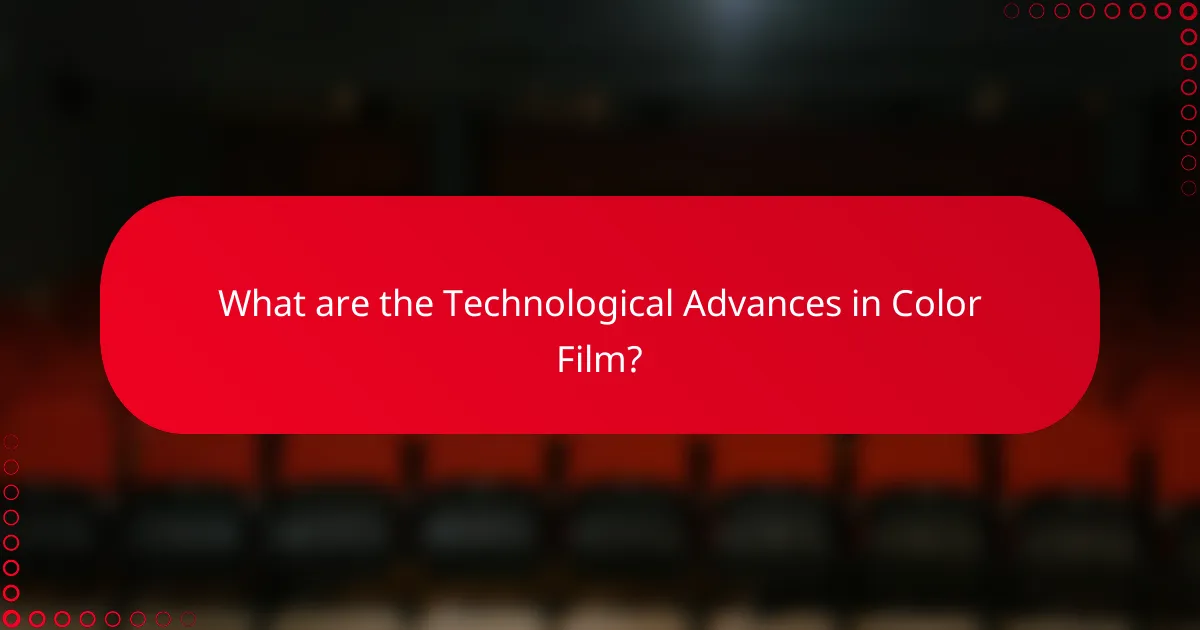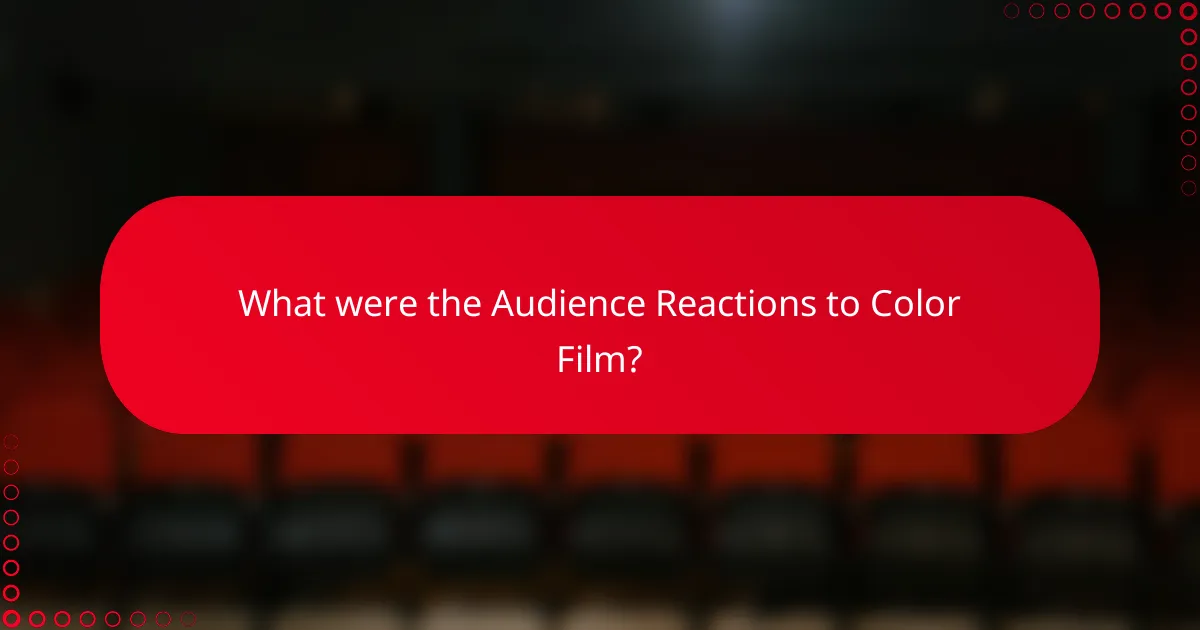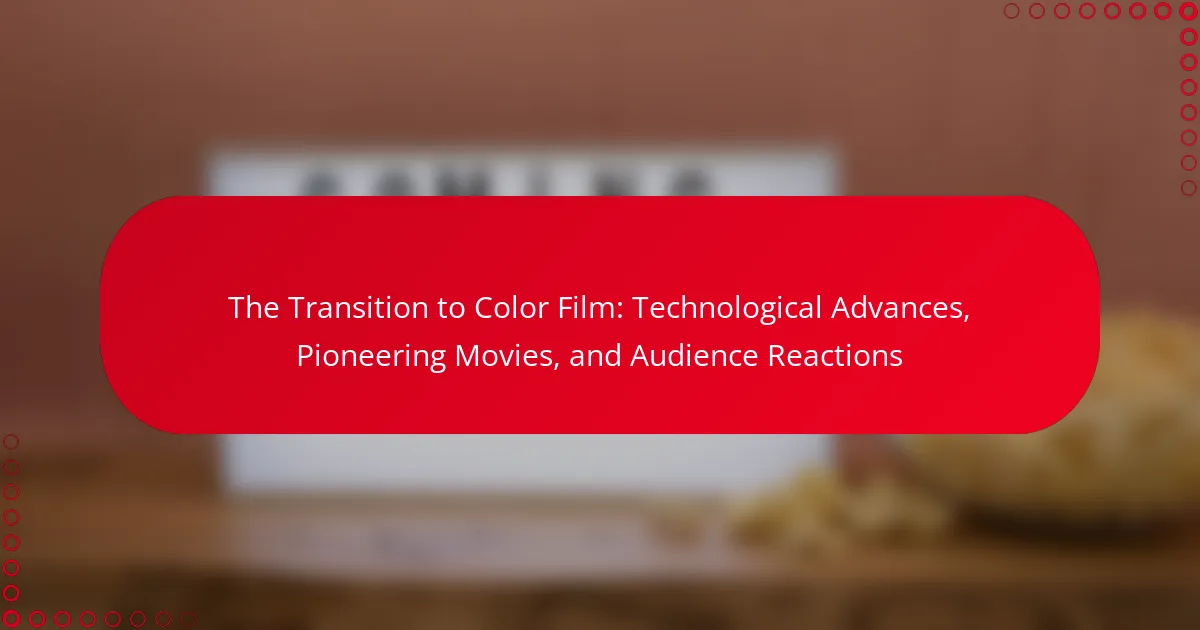The transition to color film represents a significant shift in the film industry from black-and-white to color cinematography, beginning in the early 20th century. Key technological advancements include the introduction of Technicolor in the 1930s and Eastmancolor in the 1950s, which enhanced the vibrancy and accessibility of color films. Pioneering movies such as “The Toll of the Sea,” “Wings,” and “Becky Sharp” played crucial roles in this evolution, showcasing early color techniques and influencing audience expectations. The reception of color film was largely positive, as viewers appreciated the emotional engagement and visual richness it added to storytelling, marking a new era in cinematic experience.

What is the Transition to Color Film?
The transition to color film refers to the shift from black-and-white to color cinematography in the film industry. This change began in the early 20th century with experiments in color processes. The first successful color film was “The Toll of the Sea” in 1922, using the two-color process. By the 1930s, Technicolor introduced a three-color process that became the standard for Hollywood films. Iconic films like “The Wizard of Oz” and “Gone with the Wind” showcased this technology in the late 1930s. The transition influenced audience expectations and preferences for visual storytelling. By the 1960s, color film became the norm, with black-and-white films becoming rare. This evolution marked a significant milestone in cinematic history.
How did the transition from black and white to color film occur?
The transition from black and white to color film occurred through technological advancements and experimentation. Early attempts at color film began in the late 19th century with processes like Kinemacolor. The first successful feature-length color film was “The Toll of the Sea” in 1922, showcasing two-color techniques. By the 1930s, Technicolor developed a three-color process that became the industry standard. The release of “The Wizard of Oz” in 1939 popularized color films among audiences. By the 1950s, color film became more accessible, leading to widespread adoption. The transition was influenced by audience demand for more vibrant visuals in storytelling.
What technological advancements facilitated this transition?
The transition to color film was facilitated by several key technological advancements. The introduction of the three-color process in the 1930s allowed filmmakers to capture vibrant colors on screen. This method used separate film strips for red, green, and blue, which were then combined. The Technicolor process, developed in 1916, became the industry standard for color films. Its commercial success was evident in films like “The Wizard of Oz” and “Gone with the Wind.” Advances in film stock sensitivity improved the quality of color reproduction. Additionally, innovations in camera technology allowed for more efficient color filming. These advancements collectively transformed the cinematic experience, making color films more appealing to audiences.
What were the key milestones in the development of color film?
The key milestones in the development of color film include several significant innovations. In 1907, the first successful color process, Autochrome, was introduced. This process utilized dyed grains of starch to produce color images. In 1935, Technicolor released its three-color process, revolutionizing the industry. This method used separate film strips for red, green, and blue. The first feature film to use this process was “Becky Sharp.” In 1950, Eastman Kodak introduced Kodachrome, which became popular for both film and still photography. The 1960s saw the rise of Eastmancolor, simplifying color filming for filmmakers. By the 1970s, color film became the standard in the industry, with black and white films declining in popularity. These milestones collectively transformed the visual landscape of cinema.
Why is the transition to color film significant in cinema history?
The transition to color film is significant in cinema history because it transformed visual storytelling. Color film enhanced the emotional impact of movies. It allowed filmmakers to create more vivid and engaging narratives. The first successful color process, Technicolor, debuted in the 1930s. This innovation was showcased in films like “The Adventures of Robin Hood” in 1938. The use of color attracted larger audiences and increased box office revenues. By the 1960s, color became the standard in filmmaking. This shift marked a pivotal change in the aesthetic and cultural landscape of cinema.
How did color film change the visual storytelling in movies?
Color film revolutionized visual storytelling in movies by introducing a new dimension of realism and emotional depth. The use of color allowed filmmakers to convey mood and atmosphere more effectively. It enabled audiences to experience a more immersive narrative. For instance, the 1939 film “The Wizard of Oz” showcased vibrant colors to enhance its fantastical elements. This contrast between black and white and color emphasized emotional transitions. Color also facilitated character differentiation and thematic symbolism. As a result, filmmakers began to exploit color palettes to influence audience perception. Overall, color film marked a significant evolution in cinematic expression and storytelling techniques.
What impact did color film have on audience engagement?
Color film significantly enhanced audience engagement. It captivated viewers with vibrant visuals. The introduction of color created a more immersive experience. Audiences were drawn to the emotional depth conveyed through color. Films like “The Wizard of Oz” showcased this impact effectively. Research indicates that color increased ticket sales and viewership. Studies show that audiences felt more connected to characters in color films. This shift marked a pivotal moment in cinematic history.

What are the Technological Advances in Color Film?
Technological advances in color film include the development of Technicolor, Eastmancolor, and digital color grading. Technicolor, introduced in the 1930s, utilized a three-color process that enhanced vibrancy. This process was first popularized in films like “The Adventures of Robin Hood” (1938). Eastmancolor, introduced in the 1950s, simplified the color film process with a single-strip film. This innovation made color film more accessible and affordable for filmmakers. Digital color grading emerged in the late 1990s, allowing filmmakers to manipulate color during post-production. This technology provided greater creative control over the final look of films. Each of these advances significantly impacted the aesthetics and production of movies.
What innovations were introduced during the development of color film?
The development of color film introduced several key innovations. Early color processes included the Kinemacolor system, which utilized two color filters. This method created a more vibrant image than previous techniques. The three-color process, developed by Technicolor, became a major breakthrough. It used red, green, and blue filters to produce a full-color image. This process was first used in the 1930 film “Becky Sharp.” Another innovation was the use of color dyes in film stock, which improved color accuracy and stability. The introduction of Eastmancolor in the 1950s made color film more accessible to filmmakers. These innovations collectively transformed the cinematic experience, allowing for richer storytelling through visuals.
How did Technicolor revolutionize the film industry?
Technicolor revolutionized the film industry by introducing vibrant color to movies. This technology allowed filmmakers to create visually stunning films that captivated audiences. The first successful use of Technicolor was in the 1935 film “Becky Sharp.” This film showcased the three-color process, which produced rich and realistic colors. The success of Technicolor led to its widespread adoption in Hollywood. By the 1940s, many major films utilized Technicolor, transforming the cinematic experience. Iconic movies like “The Wizard of Oz” and “Gone with the Wind” exemplified its impact. Technicolor not only enhanced storytelling but also attracted larger audiences. The innovation set a new standard for visual storytelling in cinema.
What role did film stock and processing methods play in color film technology?
Film stock and processing methods were crucial in the development of color film technology. Film stock refers to the type of film used to capture images, while processing methods involve the chemical treatments applied to develop those images. Early color films utilized subtractive color processes, which required specific film stocks designed to capture red, green, and blue light. The introduction of Kodachrome in the 1930s marked a significant advancement. This film stock allowed for vibrant color reproduction and was processed using a complex development method that enhanced image quality.
Processing methods also evolved, with advancements like the C41 process improving color consistency and stability. These innovations enabled filmmakers to achieve realistic colors, making color films more appealing to audiences. The combination of specialized film stocks and refined processing techniques played a pivotal role in the successful transition from black and white to color cinema, fundamentally changing the film industry.
How did advancements in technology improve color film quality?
Advancements in technology significantly improved color film quality through enhanced chemical processes and better film stock. Innovations in dye couplers allowed for more vibrant and accurate color reproduction. The introduction of Eastmancolor in the 1950s provided a simpler, more effective three-color process. This new method increased the stability and longevity of color images. Additionally, advancements in cameras and projectors improved the precision of color capture and display. The development of digital technology further refined color grading and correction techniques. These technological improvements resulted in films with richer colors and greater detail. Historical examples include “The Wizard of Oz” and “Gone with the Wind,” which showcased the potential of color film.
What are the differences between early color films and modern color films?
Early color films used basic color processes like Technicolor, which often resulted in oversaturated colors. Modern color films utilize advanced digital color grading techniques, allowing for a wider color spectrum and more nuanced tones.
Early color films often had limited color palettes and could appear unnatural. In contrast, modern films can achieve realistic color reproduction, enhancing visual storytelling.
Additionally, early color films required extensive lighting adjustments to compensate for color film stock limitations. Modern films benefit from digital technology, which allows for greater flexibility in lighting and post-production adjustments.
The transition from film to digital formats has also changed the way color is captured and displayed. Modern color films often employ HDR (High Dynamic Range) techniques, providing deeper contrasts and more vibrant colors.
Overall, the differences between early and modern color films reflect advancements in technology, resulting in richer, more realistic visual experiences.
How have digital technologies influenced the evolution of color film?
Digital technologies have significantly transformed the evolution of color film. The introduction of digital cameras allowed filmmakers to capture images with greater precision and flexibility. Digital editing software enabled more efficient post-production processes. This technology also facilitated the use of visual effects and color grading, enhancing the overall aesthetic of films. Additionally, digital projection systems improved the distribution and viewing experience of color films. According to a 2014 report by the International Telecommunication Union, over 90% of theaters worldwide have transitioned to digital projection. This shift has made color films more accessible to audiences globally.

What are the Pioneering Movies that Featured Color Film?
The pioneering movies that featured color film include “The Toll of the Sea” (1922), “Wings” (1927), and “Becky Sharp” (1935). “The Toll of the Sea” was one of the first films to use two-color Technicolor. “Wings” won the first Academy Award for Best Picture and showcased early color techniques. “Becky Sharp” is notable for being the first feature film shot entirely in three-color Technicolor. These films played a significant role in the evolution of color in cinema.
Which films are considered milestones in the use of color?
The films considered milestones in the use of color include “The Wizard of Oz” and “Gone with the Wind.” “The Wizard of Oz,” released in 1939, showcased Technicolor in a groundbreaking way. Its use of vibrant color contrasted with the sepia tones of Kansas. This technique highlighted the fantastical elements of Oz. “Gone with the Wind,” also from 1939, utilized color to enhance emotional depth. Its rich hues contributed to the film’s dramatic storytelling. Both films set new standards for color cinematography. They influenced future filmmakers in their approach to color in cinema.
What were the first feature films to utilize color effectively?
The first feature films to utilize color effectively were “The Toll of the Sea” (1922) and “Wings” (1927). “The Toll of the Sea” was notable for its use of two-color Technicolor. It showcased vibrant colors to enhance the storytelling. “Wings” was the first film to win an Academy Award for Best Picture. It utilized a more advanced three-color Technicolor process. Both films set a precedent for future color films. Their innovative use of color captivated audiences and influenced filmmakers.
How did these pioneering films shape audience perceptions of color film?
Pioneering films significantly shaped audience perceptions of color film by showcasing its artistic potential and enhancing storytelling. Early color films, such as “The Wizard of Oz” and “Gone with the Wind,” captivated audiences with vibrant visuals. These films demonstrated that color could evoke emotions and create immersive experiences. The use of color in these narratives established a new standard for visual aesthetics in cinema. Audiences began to associate color with higher production values and greater artistic expression. As a result, color film became a desirable format for filmmakers and viewers alike. This shift in perception paved the way for the widespread adoption of color in the film industry.
What genres benefited from the introduction of color film?
Musicals, animated films, and fantasy genres significantly benefited from the introduction of color film. Musicals utilized vibrant colors to enhance performances and visual storytelling. Animated films became more appealing with colorful characters and backgrounds, attracting wider audiences. Fantasy genres thrived as color brought imaginary worlds to life, enriching the viewer’s experience. Historical epics also gained depth and realism through color, making settings and costumes more authentic. These genres leveraged color to evoke emotions and create memorable cinematic moments, demonstrating the transformative impact of color film on storytelling.
How did color film enhance the experience of musicals and animations?
Color film significantly enhanced the experience of musicals and animations by adding visual vibrancy and emotional depth. The use of color allowed filmmakers to create more engaging and dynamic scenes. Bright colors in musicals intensified the energy of performances and highlighted choreography. In animations, color brought characters and settings to life, making them more relatable and appealing to audiences. Historical examples include “The Wizard of Oz,” which used color to symbolize emotional transitions. This transition from black-and-white to color film engaged viewers’ senses and deepened their emotional connection to the story. Color film also allowed for innovative storytelling techniques, such as color symbolism and mood setting. Overall, color film transformed the visual landscape of musicals and animations, enhancing audience enjoyment and experience.
What role did color play in the depiction of different genres?
Color played a significant role in the depiction of different genres in film. It enhanced emotional expression and visual storytelling. For instance, horror films often used stark contrasts and dark colors to evoke fear. In contrast, musicals utilized vibrant colors to create a joyful atmosphere. Historical dramas employed muted tones to convey authenticity and seriousness. The use of color also helped differentiate genres, making it easier for audiences to identify themes. Research shows that color psychology influences viewer perceptions, impacting their emotional responses to various genres. Overall, color became a crucial element in defining and enhancing cinematic experiences across genres.

What were the Audience Reactions to Color Film?
Audience reactions to color film were largely positive. Viewers were captivated by the vividness and realism that color brought to cinema. The introduction of color enhanced emotional engagement with stories. Audiences appreciated the visual richness in films like “The Wizard of Oz” and “Gone with the Wind.” Many found color to be a significant improvement over black and white. Some critics, however, argued that color could distract from storytelling. Overall, color film was seen as a groundbreaking advancement in the film industry. The transition to color films marked a new era in cinematic experience.
How did audiences initially respond to color films?
Audiences initially responded to color films with excitement and curiosity. The introduction of color enhanced visual storytelling. Many viewers found the experience more immersive compared to black-and-white films. This shift marked a significant technological advancement in cinema. Early color films like “The Wizard of Oz” and “Gone with the Wind” captivated audiences. The vibrant visuals attracted larger crowds to theaters. However, some critics expressed skepticism about the necessity of color. They argued that it could distract from the narrative. Despite mixed reviews, color films quickly gained popularity and transformed the film industry.
What factors influenced audience acceptance of color film?
Audience acceptance of color film was influenced by technological advancements, aesthetic appeal, and cultural context. Technological advancements made color film more accessible and affordable for filmmakers. The introduction of processes like Technicolor in the 1930s showcased vibrant visuals. Aesthetic appeal played a crucial role as audiences were captivated by the richness of color. Iconic films such as “The Wizard of Oz” and “Gone with the Wind” demonstrated color’s potential. Cultural context also shaped acceptance, as post-war optimism encouraged new artistic expressions. The combination of these factors led to a gradual shift in audience preference towards color films.
How did critical reception evolve with the introduction of color films?
Critical reception evolved significantly with the introduction of color films. Initially, critics were skeptical about color’s impact on storytelling. They feared it might distract from the narrative. However, as filmmakers began to use color effectively, perceptions shifted. Iconic films like “The Wizard of Oz” in 1939 showcased color’s potential to enhance emotional depth. Critics started to appreciate color as a tool for artistic expression. By the 1950s, color films gained widespread acceptance. The technological advancements in color processes improved visual quality. This evolution led to a more favorable critical landscape for color cinema.
What lasting effects did the transition to color film have on audience expectations?
The transition to color film significantly elevated audience expectations regarding visual storytelling. Audiences began to associate color with realism and emotional depth. This shift led to a demand for more vibrant and visually appealing cinematography. Films like “The Wizard of Oz” (1939) showcased color’s potential, setting a new standard. As a result, filmmakers were challenged to innovate in visual presentation. The expectation for color also influenced genres, with musicals and fantasy films particularly benefiting. Over time, color became a norm, making black-and-white films feel outdated. This evolution fundamentally changed how stories were told and perceived on screen.
How has the perception of color in film changed over time?
The perception of color in film has evolved significantly since its inception. Early films were primarily black and white, which limited visual storytelling. The introduction of Technicolor in the 1930s marked a pivotal change. Films like “The Wizard of Oz” showcased vibrant colors, influencing audience expectations. Over the decades, color became essential for emotional impact and narrative depth. By the 1970s, filmmakers began using color symbolically to enhance themes. Today, color grading technology allows for precise control over visual aesthetics. This evolution reflects broader cultural shifts, as audiences now associate color with realism and artistic expression.
What do modern audiences expect from color films today?
Modern audiences expect color films to deliver high-quality visuals and immersive storytelling. They seek vibrant colors that enhance emotional engagement. Audiences also demand advanced special effects that create realistic environments. Strong character development is essential for audience connection. They appreciate diverse narratives that reflect contemporary society. High production values are expected, including sound and cinematography. Viewers often look for innovative techniques in filmmaking. Overall, modern audiences desire a seamless blend of artistry and technology in color films.
What can we learn from the transition to color film for future innovations?
The transition to color film teaches us the importance of innovation in enhancing viewer engagement. It demonstrates that technological advancements can significantly transform artistic expression. The introduction of color film in the 1930s revolutionized cinema, making stories more vivid and emotionally impactful. This shift attracted larger audiences and increased box office revenues. Historical examples include “The Wizard of Oz” and “Gone with the Wind,” which showcased color’s potential. These films not only captivated audiences but also set new standards for filmmaking. Future innovations can draw from this by prioritizing user experience and emotional connection. Embracing new technologies can lead to groundbreaking developments in various fields.
The main entity of the article is the transition to color film in the cinema industry. This article provides an overview of the technological advancements that facilitated the shift from black-and-white to color cinematography, highlighting key milestones such as the introduction of Technicolor and pioneering films like “The Wizard of Oz” and “Gone with the Wind.” It explores the impact of color film on audience engagement and expectations, as well as the evolution of critical reception over time. Additionally, the article discusses the significant role of color in enhancing visual storytelling across various genres and the lasting effects of this transition on modern filmmaking.
